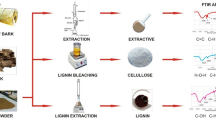Abstract
From two-day etiolated shoots of the cotton plant of variety 108-F we have isolated the total histone and purified it on a column of CM-cellulose. It has been shown by gel electrophoresis and amino acid analysis that the total histone of the cotton plant, like the total histone of wheat, consists of five main fractions, the amount of the lysine-rich fraction A1 being greater in the cotton plant than in wheat (23% and 19%, respectively), and the amount of arginine-rich fraction A4 being less (19.2 and 24.3%, respectively). The total histone of the cotton plant is less basic (ratio of basic amino acids to acidic amino acids in the cotton-plant histone 1.24, in wheat histone 1.9, and in calf thymus histone 1.78) but richer in lysine as compared with arginine than the histones of wheat and calf thymus.
Similar content being viewed by others
Literature cited
L. V. Gofshtein, Biokhimiya,43, 947 (1978).
V. G. Alfrey, V. G. Littay, and A. E. Mirsky, J. Cell. Biol.,21, 213 (1964).
M. O. Krause and G. S. Stein, Exp. Cell. Res.,100, 63 (1976).
Yu. A. Tyrsin and I. A. Krasheninnikov, Lab. Delo,10, 618 (1975).
L. V. Gofshtein, V. I. Safonov, and N. M. Sisakyan, Dokl. Akad. Nauk SSSR,167, 1168 (1966).
A. P. Ibragimov, Sh. Yunushkhanov, M. P. Ibragimkhodzhaeva, B. Abdurakhmanova, and G. B. Saidova, Dokl. Akad. Nauk UzSSR, No. 2, 53 (1975).
S. A. Rakhmankulov, R. Abidov, and E. G. Zapruder, Uzb. Biol. Zh., No. 2, 39 (1976).
U. D. Barett and E. W. Johns, J. Chromatogr.,75, 161 (1973).
M. Tazal and R. D. Cole, J. Biol. Chem.,252, No. 12, 4068 (1977).
V. V. Sidorova, T. P. Kopitsya, G. F. Kasymova, N. I. Koryakina, V. K. Burichenko, and V. G. Konarev, Dokl. Akad. Nauk TadzhSSR,21, No. 4, 31 (1978).
E. A. Britikov, The Biological Role of Proline [in Russian], Moscow (1975).
T. Devenyi and J. Gergely, Amino Acids, Peptides and Proteins, Elsevier, New York (1974).
S. Panyim and R. Chalkey, Arch. Biochem. Biophys.,130, 337 (1969).
H. Busch, Histones and Other Nuclear Proteins, Academic Press, New York (1965).
L. V. Gofshtein, Biokhimiya,32, No. 5, 959 (1967).
Additional information
V. I. Nikitin Institute of Chemistry, Academy of Sciences of the Tadzhik SSR, Dushanbe. Translated from Khimiya Prirodnykh Soedinenii, No. 1, pp. 109–112, January–February 1980.
Rights and permissions
About this article
Cite this article
Kopitsya, T.P., Koryakina, N.I., Kasymova, G.F. et al. Study of the total histone of the cotton plant of variety 108-F. Chem Nat Compd 16, 92–95 (1980). https://doi.org/10.1007/BF00564889
Received:
Issue Date:
DOI: https://doi.org/10.1007/BF00564889




